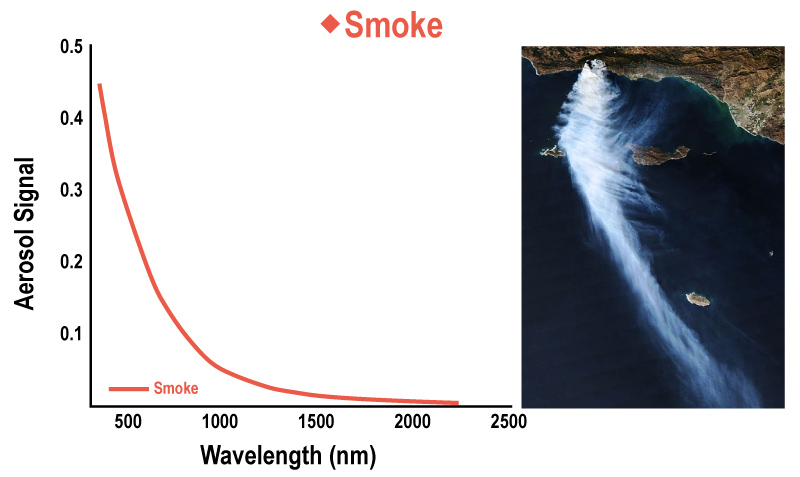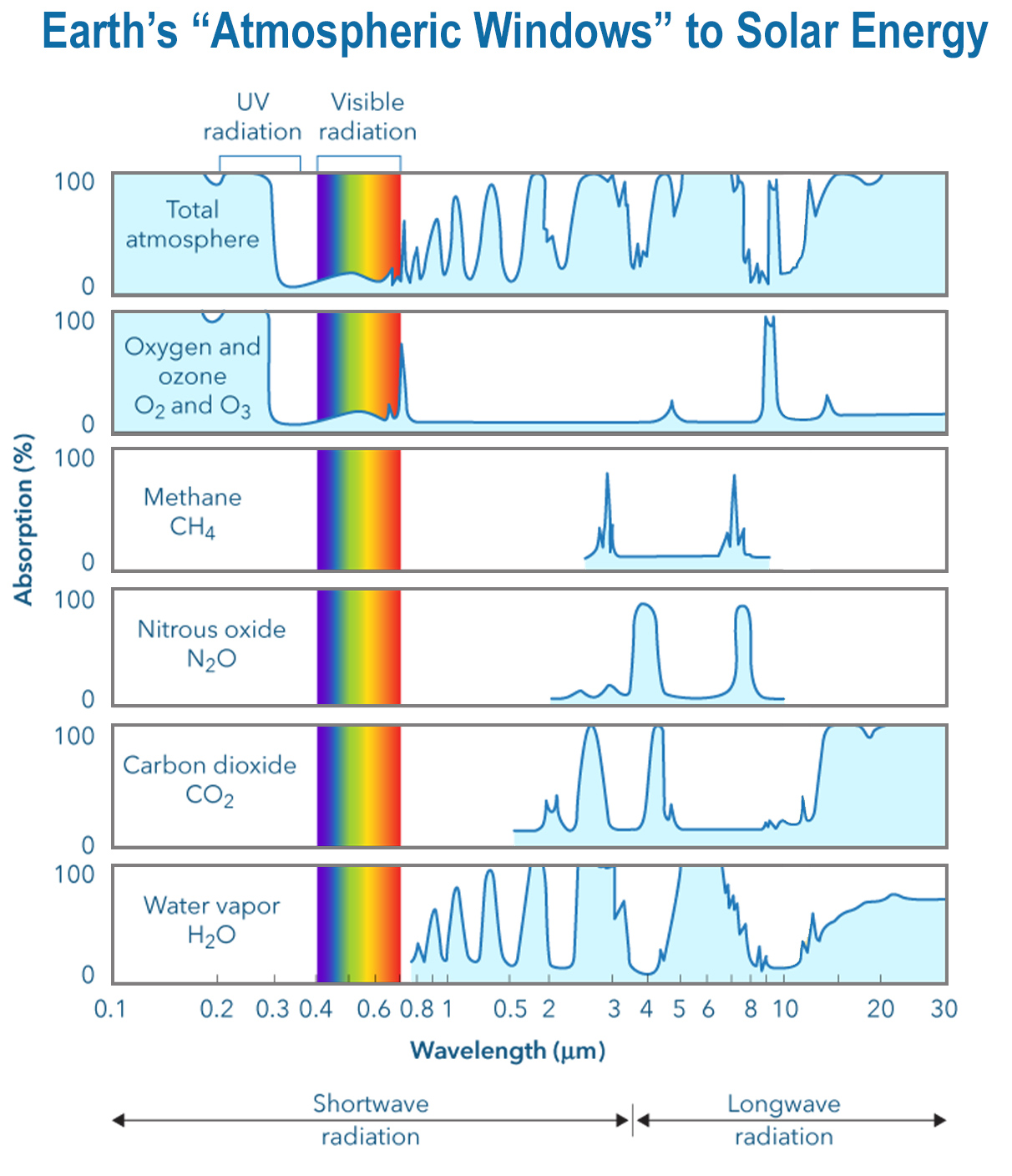Shedding Light on PACE
Section III: How Does the Atmosphere Interact With Light?
Light Attenuation Through the Atmosphere | What's That Stuff in the Atmosphere? | Measuring What's in the Atmosphere | Advanced Topic – Travel Through Atmospheric Windows | Why is a Red Sky at Night a Sailor's Delight?
Light Attenuation Through the Atmosphere
The electromagnetic spectrum ranges from gamma rays to radio waves. However, the light that reaches the surface of the Earth does not contain this full suite of wavelengths. So what happened along the way between open space and the Earth’s surface? Well, the light had to make its way through the Earth’s atmosphere. The light that travels through the atmosphere is altered by attenuation. Click here for a deeper dive into attenuation .
One important element of light attenuation through the atmosphere is that not all wavelengths of light are reduced the same as they move toward the surface of the Earth -- some wavelengths of light pass easily through the atmosphere, while other wavelengths interact with components of the atmosphere and do not reach the surface of the Earth. The bands of wavelengths where light passes through the atmosphere unhindered are referred to as atmospheric windows. Check out the section below on atmospheric windows.


What's That Stuff in the Atmosphere?
Lots of stuff in the atmosphere can interact with light as it travels from the top of the atmosphere to Earth's surface. They range in size from gas molecules to tiny particles of smoke or dust to huge clouds comprised of water in various forms.
Gases blocking sunlight? That's right, tiny molecules that appear transparent to your eyes are actually blocking light from reaching the Earth! By volume, the dry air in Earth’s atmosphere is about 78% nitrogen, 21% oxygen, and 0.9% argon. The remaining less than 1% is a mixture of many other gases, including greenhouse gases like carbon dioxide, methane, nitrous oxide and ozone. Learn more about atmospheric gases in this NASA Climate article.
Anyone who has looked out an airplane window at the top of the clouds knows how bright the surface of a cloud can be. When it comes to spectra, however, clouds have a lot of variation. This is because they are constantly changing between different forms of water: liquid, vapor, ice. Sometimes you can see high, wispy clouds situated above low, thick clouds on the horizon. Different types of clouds have different spectral signatures, which depend on their composition, size, shape, and altitude.
Particles in the atmosphere are collectively known as aerosols. Particulate aerosols of particular interest to the PACE Mission include:
- Sea Spray - These naturally occurring aerosols are generated by the action of ocean waves, which propel salt particles into the air. When lifted high aloft, clouds can condense around sea salt aerosols. As the oceans cover about two thirds of Earth's surface there is a lot of sea spray in total. However, the amount in any one place tends to be low except for areas of rough seas, such as near the poles, or areas of tropical storms and hurricanes.
- Smoke - Many manmade and natural phenomena send smoke into the atmosphere, including wildfires, agricultural burning, power plants, factory emissions, and car exhaust. These particles can significantly reduce air quality, leading to asthma and respiratory distress among vulnerable people. Over the long term, smoke aerosols absorb and reflect different fractions of sunlight, affecting how much energy Earth absorbs from the Sun.
- Dust - Dust reflects strongly over a wide range of the electromagnetic spectrum from visible to infrared wavelengths. Dust is found where soil is blown loose by the wind, such as deserts and dry lake beds or glaciers. Reflectance values are relatively high because many of the minerals scatter light strongly, and dust storms can contain a lot of dust.
Click here to learn more about aerosols.
Measuring What's in the Atmosphere
Just as bananas have spectral signatures, so do aerosols, clouds, and gases in the atmosphere. Knowing the spectral signatures of individual components of the atmosphere provides scientists with critical information to decipher which elements are being observed by PACE. Click here for more information on Spectral Signatures . PACE's onboard instruments work synergistically to decode complex signals of light into atmospheric components using three main sensors: the Ocean Color Instrument (OCI), and two polarimeters (SPEXone and HARP2).
The OCI is a highly advanced optical spectrometer that enables continuous measurement of light at fine wavelength resolution. These hyperspectral light sensing capabilities reveal a detailed range of colors reflected from the ocean and atmosphere, i.e., a detailed spectral signature. The more detailed the spectral signature, the more scientists can learn about the components of the ocean and atmosphere. Read more about how the detailed spectral information from the OCI informs science .
The OCI alone, however, cannot provide all the information scientists need to decode the complex light signatures received by the PACE satellite. In particular, the OCI is not able to decipher "polarized" light signatures. Light is sometimes polarized. This principle allows you to reduce the glare reaching your eyes when you wear sunglasses to the beach. The PACE satellite’s pair of polarimeters aid in gathering the information contained in this polarized signal.
But what is polarization? We learned in Section I: Fundamental Properties of Light that as photons of light travel they oscillate in waves, these waves simultaneously occur horizontal and vertical planes. Polarization refers breaking down that oscillation into just the vertical plane or horizontal plane. Learn more about polarized light in The Air Down There e-brochure .
Knowing more about the polarization of light helps scientists learn more about the composition of the atmosphere. Specifically, HARP2 provides information on clouds and SPEXone focuses on characterizing aerosols in our atmosphere. To learn more, check out the PACE StoryMap Something New Under the Sun.
Click on the colored diamonds below to explore aerosols and their spectra.


Advanced Topic – Travel Through Atmospheric Windows
As solar radiation travels through the atmosphere, there are several key bands of radiation that penetrate further than others, based on interactions with specific molecules in the atmosphere. These are called atmospheric windows. Most important of these windows are those around the bands of visible light and infrared radiation. These windows allow light to enter the atmosphere and allow heat (infrared radiation) to leave the Earth. Read more about the Solar Spectrum.
Gaseous components of Earth's atmosphere interact with both incoming solar radiation and outgoing radiation that has been re-radiated from Earth. As radiation strikes gas molecules in the atmosphere, the energy dissipates into longer wavelength infrared radiation, or heat. Notice the greenhouse gases (i.e., carbon dioxide, water vapor) have high absorption in the infrared wavelengths.
In this figure, blue shading indicates the wavelengths where gases in the Earth's atmosphere absorb light. Atmospheric windows are depicted as rainbow-colored and red/orange bands, indicating where radiation can pass between space and Earth's surface with minimal disruption.
Why is a Red Sky at Night a Sailor's Delight?
"Red sky at night, sailors' delight. Red sky at morning, sailors take warning." This old saying has been helping seafarers somewhat reliably predict the weather for millennia (well, at least in the northern hemisphere). But why does it work, and what does the color of the sky have to do with the weather?
Let's ask instead: why does the sky appear to be red at times? As we have learned, the gases in the atmosphere scatter light. During sunrise and sunset, the light from the Sun is at a very low angle to the Earth. At those times, rays of light must pass through a thick layer of the atmosphere to reach the Earth's surface. As the light travels through the atmosphere many of the shorter (i.e., more blue) wavelengths of light are scattered, leaving the longer (i.e., more red) wavelengths to predominate the colors we see. The more "stuff" in the atmosphere, the more scattering occurs and the redder the sky becomes!
Back to the weather. High pressure systems have more "stuff," i.e., water vapor, in the atmosphere so when the Sun shines through a high pressure cell as it either rises or sets, it will look red on Earth to us. High pressure areas are also areas of good weather. In the northern hemisphere at mid-latitudes, weather cells typically move from west to east. So if you are looking to the west at sunset and see a red sky ("Red sky at night"), a high pressure cell is moving your way with good weather. If you are looking to the east at sunrise and see a red sky ("Red sky at morning"), the high pressure cell has moved passed you and storms may be approaching. If you are in the southern hemisphere the prevailing winds generally move in the opposite direction and you would be pretty pleased with a red sunrise.
Want to learn more? Check out article from the Library of Congress.






